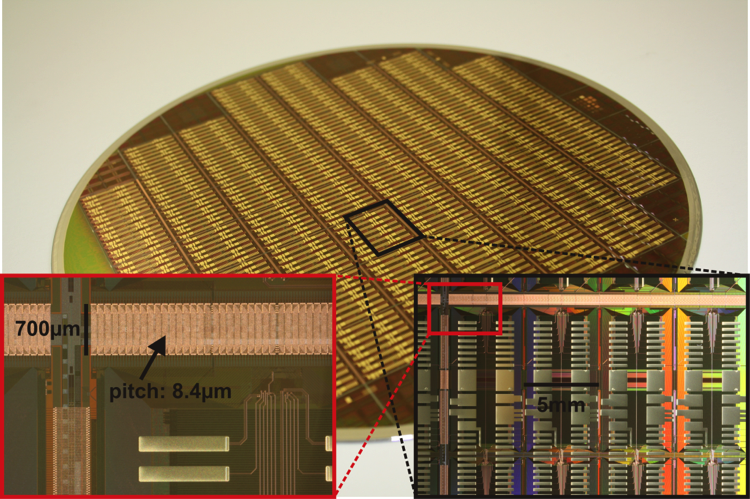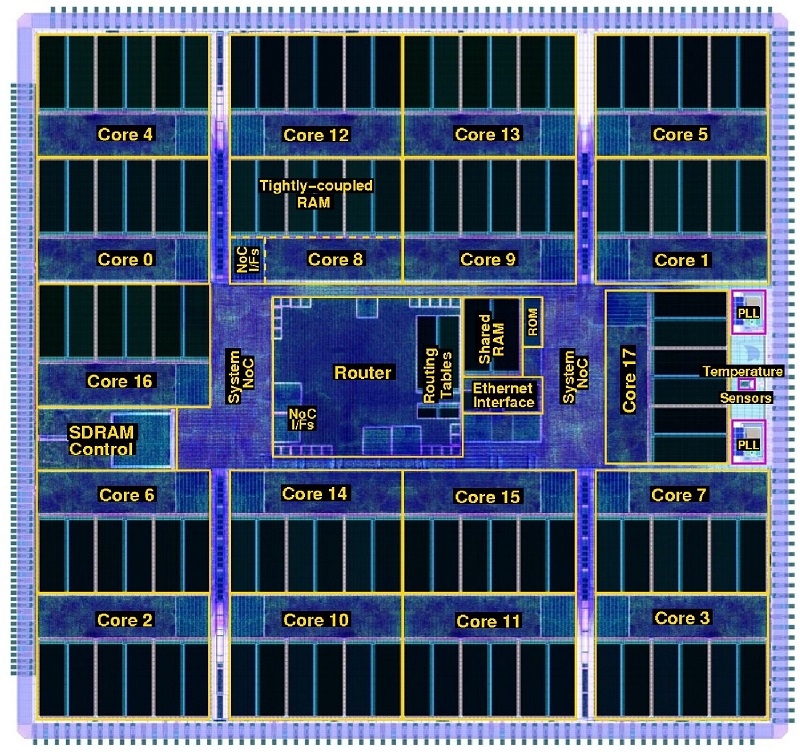Neuromorphic computing – brain inspired computing – has long been a tantalizing goal. The human brain does with around 20 watts what supercomputers do with megawatts. And power consumption isn’t the only difference. Fundamentally, brains ‘think differently’ than the von Neumann architecture-based computers. While neuromorphic computing progress has been intriguing, it has still not proven very practical.
This week neuromorphic computing takes another step forward with a workshop being offered to users from academia, industry and education interested in using two European neuromorphic systems that have been years in development and are coming online for broader use – the BrainScaleS system launching at the Kirchhoff Institute for Physics of Heidelberg University and SpiNNaker, a complementary approach and similarly sized system at the University of Manchester.
Ramping up BrainScaleS and SpiNNaker is an important milestone, strengthening Europe’s position in hardware development for alternative computing. Both projects are part of the European Human Brain Project, originally funded by the European Commission’s Future Emerging Technologies program (2005-2015). The webcast, which will be streamed live on Tuesday, will cover the architecture for both systems and approaches to application development.
BrainScaleS and SpiNNaker take different tacks for modeling neuron activity. One approach is to use traditional analog circuits — like the chips being developed by the BrainScaleS. Analog circuits can be fast and energy and efficient. Conversely, SpiNNaker’s architecture closely links a very large number of digital cores (also fast, and in this case, also energy efficient).

BrainScaleS’s neuromorphic hardware is based around wafer-scale analog, very large scale integration (VLSI). Each 20-cm-diameter silicon wafer contains 384 chips, each of which implements 128,000 synapses and up to 512 spiking neurons[i]. This gives a total of around 200,000 neurons and 49 million synapses per wafer. These VLSI models operate considerably faster than the biological originals and allow the emulated neural networks to evolve tens-of-thousands times quicker than real time. Put another way, a biological day of learning can be compressed to 100 seconds on the machine.
Leader of the BrainScaleS project, Prof. Dr. Karlheinz Meier (Heidelberg University) explains, “The BrainScaleS system goes beyond the paradigms of a Turing machine and the von Neumann architecture. It is neither executing a sequence of instructions nor is it constructed as a system of physically separated computing and memory units. It is rather a direct, silicon based image of the neuronal networks found in nature, realizing cells, connections and inter-cell communications by means of modern analogue and digital microelectronics.”
Learning – not external programming – is a key guiding principle. Unlike traditional computer architecture in which a structured program explicitly carries out an order of tasks, brains are fundamentally learning machines that turn patterns into programs.
Steve Furber, a professor at the University of Manchester and a co-designer of the ARM chip architecture, leads the SpiNNaker team. SpiNNaker is a contrived acronym derived from Spiking Neural Network Architecture. The machine consists of 57,600 identical 18-core processors, giving it 1,036,800 ARM968 cores in total. The die is fabricated by United Microelectronics Corporation (UMC) on a 130 nm CMOS process. Each System-in-Package (SiP) node has an on-board router to form links with its neighbors, as well as 128 Mbyte off-die SDRAM to hold synaptic weights.
 SpiNNaker, too, is built to mimic the brain’s biological structure and behavior. It will exhibit massive parallelism and resilience to failure of individual components. With more than one million cores, and one thousand simulated neurons per core, SpinNNaker should be capable of simulating one billion neurons in real-time. This equates to a little over one percent of the human brain’s estimated 85 billion neurons.
SpiNNaker, too, is built to mimic the brain’s biological structure and behavior. It will exhibit massive parallelism and resilience to failure of individual components. With more than one million cores, and one thousand simulated neurons per core, SpinNNaker should be capable of simulating one billion neurons in real-time. This equates to a little over one percent of the human brain’s estimated 85 billion neurons.
Rather than implement one particular algorithm, SpiNNaker will be a platform on which different algorithms can be tested. Various types of neural networks can be designed and run on the machine, thus simulating different kinds of neurons and connectivity patterns.
Both BrainScaleS and SpiNNaker architectures will be discussed during the Web-based workshop on March 22, scheduled from 3 pm to 6 pm CET. Together, the systems located in Heidelberg and Manchester comprise the “Neuromorphic Computing Platform” of the Human Brain Project.
Much of the early work on both machines will be basic research on self-organization in neural networks. Other potential applications, for example, are in energy and time efficiency optimization, broadly similar to deep learning technology developed by companies like Google and Facebook for the analysis of large data volumes using conventional high performance computers.

Europe, of course, is hardly alone in pursuing neuromorphic computing. Most prominent in the U.S. is IBM Research’s TrueNorth Chip effort. Dharmendra Modha, IBM fellow and chief scientist for brain-inspired computing, wrote an interesting commentary on the TrueNorth project that traces development of von Neumann architecture based computing and contrasts it with neuromorphic computing approaches: Introducing a Brain-inspired Computer. Though written in 2014, it remains relevant.
TrueNorth chip, introduced in August 2014, is a neuromorphic CMOS chip that consists of 4,096 hardware cores, each one simulating 256 programmable silicon “neurons” for a total of just over a million neurons. Each neuron has 256 programmable “synapses” which convey the signals between them. Hence, the total number of programmable synapses is just over 268 million (228). In terms of basic building blocks, its transistor count is 5.4 billion.
Developed under the DARPA SyNAPSE (Systems of Neuromorphic Adaptive Plastic Scalable Electronics) project, TrueNorth’s computing power has been characterized as roughly equivalent to the brainpower of a rodent. It also circumvents the von-Neumann-architecture bottlenecks, is very energy-efficient, consumes merely 70 milliwatts, and is capable of 46 billion synaptic operations per second, per watt – literally a synaptic supercomputer in your palm.
BrainScaleS, SpiNNaker, and TrueNorth are just three examples of many ongoing neuromorphic computing projects. Turning them into commercial products or more general purpose computing machines remains a challenge.
Indeed, IBM put together a paper on cognitive computing commercialization and barriers[ii]. “New thinking, not only on the part of programmers and application developers, but also by organizational decision makers who seek to link technological possibilities to market opportunity. While incremental innovation can be achieved on the basis of existing knowledge in well-charted commercial territory, radical innovation entails far greater uncertainty.”
Among the barriers cited were: formulating business models and predicting future revenue to calibrate investment, defining strategy and structure to execute and finally, overcoming communicative and functional boundaries.
Much of the drive to push neuromorphic computing stems from the ongoing decline of Moore’s law, and this excerpt from a 2014 ACM article[iii] still sums circumstances today:
As the long-predicted end of Moore’s Law seems ever more imminent, researchers around the globe are seriously evaluating a profoundly different approach to large-scale computing inspired by biological principles. In the traditional von Neumann architecture, a powerful logic core (or several in parallel) operates sequentially on data fetched from memory. In contrast, “neuromorphic” computing distributes both computation and memory among an enormous number of relatively primitive “neurons,” each communicating with hundreds or thousands of other neurons through “synapses.” Ongoing projects are exploring this architecture at a vastly larger scale than ever before, rivaling mammalian nervous systems, and developing programming environments that take advantage of them. Still, the detailed implementation, such as the use of analog circuits, differs between the projects, and it may be several years before their relative merits can be assessed.
Researchers have long recognized the extraordinary energy stinginess of biological computing, most clearly in a visionary 1990 paper by the California Institute of Technology (Caltech)’s Carver Mead that established the term “neuromorphic.” Yet industry’s steady success in scaling traditional technology kept the pressure off.”
[i] “Spiking neural networks (SNNs) fall into the third generation of neural network models, increasing the level of realism in a neural simulation. In addition to neuronal and synaptic state, SNNs also incorporate the concept of time into their operating model. The idea is that neurons in the SNN do not fire at each propagation cycle (as it happens with typical multi-layer perceptron networks), but rather fire only when a membrane potential – an intrinsic quality of the neuron related to its membrane electrical charge – reaches a specific value. When a neuron fires, it generates a signal which travels to other neurons which, in turn, increase or decrease their potentials in accordance with this signal. In the context of spiking neural networks, the current activation level (modeled as some differential equation) is normally considered to be the neuron’s state, with incoming spikes pushing this value higher, and then either firing or decaying over time. Various coding methods exist for interpreting the outgoing spike train as a real-value number, either relying on the frequency of spikes, or the timing between spikes, to encode information.” From https://en.wikipedia.org/wiki/Spiking_neural_network.
[ii] For more on applications, see IBM paper, Cognitive Computing Commercialization: Boundary Objects for Communication, https://dl.dropboxusercontent.com/u/91714474/Papers/023.IDEMI’13_boundary%20objects_3.4.pdf?cm_mc_uid=86343320971914489086046&cm_mc_sid_50200000=1458418853, Presented at 3rd INT. CONF. ON INTEGRATION OF DESIGN, ENGINEERING & MANAGEMENT FOR INNOVATION, Porto, Portugal, 4-6th September 2013
[iii] Communications of the ACM, Neuromorphic Computing Gets Ready for the (Really) Big Time, http://cacm.acm.org/magazines/2014/6/175183-neuromorphic-computing-gets-ready-for-the-really-big-time/abstract




























































